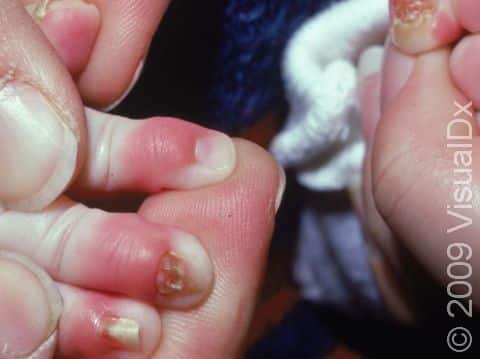Nail Infection (Paronychia)
Paronychia, commonly called a nail infection, is inflammation of the region of the finger or toe next to the nail, either at the proximal nail fold (the base of the nail) or at the lateral nail fold (on either side of the nail). Paronychia is usually caused by a bacterial infection, but it can also be caused by a virus, typically the herpes simplex virus. It can also be caused by certain medications, such as retinoids. The inflammation may occur suddenly (acute paronychia), or it may be a more low-grade long-term problem or one that keeps coming back (chronic paronychia).
In many cases of acute paronychia, there is first some sort of trauma to the nail fold (eg, a splinter, fingernail biting, tearing away a hangnail, cutting the skin while trimming the nails) that allows bacteria to enter, resulting in infection.
Acute paronychia develops fairly quickly, over a period of days.
Who's At Risk?
Paronychia may occur at any age, but acute paronychia is particularly common in children, especially in children who suck on the thumb or fingers or whose caregivers over-trim the fingernails.
Signs & Symptoms
Acute paronychia most often affects the nail fold of the thumb or fingers, or sometimes the toes.
The affected nail fold may be red, swollen, tender, and there may be an abscess (a tender bump containing pus). In the case of acute paronychia, usually only one nail is affected.
Self-Care Guidelines
If the nail infection is just affecting one or two nails and it is an acute case, you can try having the baby soak the affected nail or nails in warm water for 15 minutes 4 times a day until symptoms resolve. You can also apply an antibacterial ointment (eg, Neosporin or triple antibiotic containing neomycin, polymyxin B, and bacitracin) to the affected area 2-3 times a day.
Treatments
Your baby’s medical professional may puncture and drain the affected area and test for bacteria. Depending on the severity of the infection, the medical professional may prescribe an antibiotic.
Visit Urgency
Seek medical care if the infection does not get better within 48 hours of self-care. If the baby seems distressed or there is spreading redness or fever, seek medical care more urgently.
References
Bolognia J, Schaffer JV, Cerroni L. Dermatology. 4th ed. Philadelphia, PA: Elsevier; 2018.
James WD, Elston D, Treat JR, Rosenbach MA. Andrew’s Diseases of the Skin. 13th ed. Philadelphia, PA: Elsevier; 2019.
Kang S, Amagai M, Bruckner AL, et al. Fitzpatrick’s Dermatology. 9th ed. New York, NY: McGraw-Hill Education; 2019.
Paller A, Mancini A. Paller and Mancini: Hurwitz Clinical Pediatric Dermatology. 6th ed. St. Louis, MO: Elsevier; 2022.
Last modified on October 28th, 2024 at 2:58 pm

Not sure what to look for?
Try our new Rash and Skin Condition Finder
